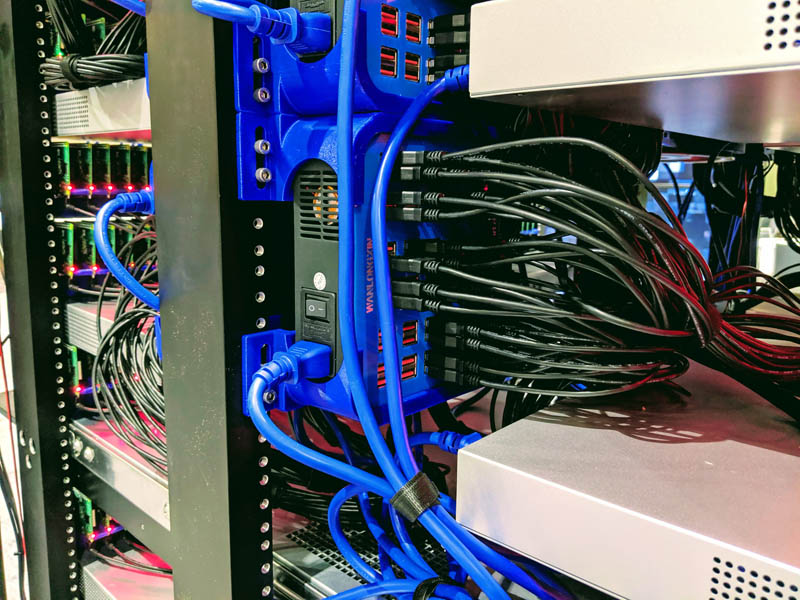Oracle's New Supercomputer Has 1,060 Raspberry Pis
One Raspberry Pi can make a nice web server, but what happens if you put more than 1,000 of them together? At Oracle's OpenWorld convention on Monday, the company showed off a Raspberry Pi Supercomputer that combines 1,060 Raspberry Pis into one powerful cluster.
According to ServeTheHome, which first reported the story, the supercomputer features scores of racks with 21 Raspberry Pi 3 B+ boards each. To make everything run well together, the system runs on Oracle Autonomous Linux.
ServeTheHome asked Oracle why it chose to create a cluster of Raspberry Pis instead of using a virtualized Arm server and one company rep said simply that "...a big cluster is cool."
Oracle engineers connected the Raspberry Pis to a series of switches (Ubiquiti UniFi Switch 48s) and uplinked them with SFP+ 10GbE transceivers. The Raspberry Pis receive their power from a series of USB power supplies.
Every unit connects to a single rebranded Supermicro 1U Xeon server, which functions as a central storage server for the whole supercomputer. The Oracle team also created custom, 3D printed brackets to help support all the Pis and connecting components.
Raspberry Pi clusters aren't practical when it comes to performance, but the novelty of supercomputer projects often make the learning experience worthwhile. We don't expect this product to go commercial, but it is a really neat example of just how much you can do with a $35 computer.
Get Tom's Hardware's best news and in-depth reviews, straight to your inbox.

Ash Hill is a contributing writer for Tom's Hardware with a wealth of experience in the hobby electronics, 3D printing and PCs. She manages the Pi projects of the month and much of our daily Raspberry Pi reporting while also finding the best coupons and deals on all tech.
-
rfeague If you're near San Francisco, Oracle has a free "Discover" pass so you can check this out in person. https://www.oracle.com/code-one/register.htmlReply -
bit_user I still don't get the point of it. Was it used to demonstrate some software of theirs? Maybe this "Autonomous Linux"?Reply -
bit_user Reply
Yeah, you'd think 4240 ARM Cortex-A53 cores should manage some impressive numbers on some kind of distributed computing benchmark.Stokestack said:And not one mention of its performance...
However, I expect such a machine is only good for research & testing of distributed computing software. Recent analysis has shown that even the much-improved Pi v4 is not a cost-effective solution for computing at scale:
https://www.servethehome.com/aoa-analysis-marvell-thunderx2-equals-190-raspberry-pi-4/ -
MeeLee Should've gone with those AMLogic S905X tv boxes. They're faster, cheaper, and easier to connectReply -
bit_user Reply
ODROID has a number of AMLogic-based products, their N2 being the latest & greatest. Here's the cheapest version:MeeLee said:Should've gone with those AMLogic S905X tv boxes. They're faster, cheaper, and easier to connect
https://www.hardkernel.com/shop/odroid-n2-with-2gbyte-ram/ -
MeeLee Reply
The AMLogic TV boards go from $25 a board, and all come with a case, remote, and power supply.bit_user said:ODROID has a number of AMLogic-based products, their N2 being the latest & greatest. Here's the cheapest version:
https://www.hardkernel.com/shop/odroid-n2-with-2gbyte-ram/
All 3 useless when going all out server.
These units run at ~1,4Ghz, however the $35/unit boards run at 2Ghz (1,8Ghz under full load), using a single 80mm fan @5V (=~0.25W) to cool 5-6 boards.
If you've got money spare, $55/board gets you the 2.2Ghz octacore in big-little configuration. Not many programs use the big cores for sustained load.
One bump higher, $120/board gets you Tegra boards.
I would only recommend them if you're running small GPU loads.
There's currently no Boinc program running on Tegra GPUs.
I wouldn't know why else one would get that many cores... -
bit_user Reply
Tegra boards don't support OpenCL. There's no technical justification for it - just a shady move by Nvidia's marketing department.MeeLee said:One bump higher, $120/board gets you Tegra boards.
I would only recommend them if you're running small GPU loads.
There's currently no Boinc program running on Tegra GPUs.
I wouldn't know why else one would get that many cores...
Anyway, my guess is Tegra either doesn't have enough resources or just that Boinc needs OpenCL.
It's no big loss, though. If you compare specs, Tegra SoCs line up pretty well with Intel's iGPUs. Yes, really. Tegra are only good for their size and power budget, but in absolute compute terms they're not even equal to a GTX 1030. -
MeeLee Reply
Plus, the CPU is ARM, so you'd only be able to get jobs from Android compatible projects; which only support CPU anyway.bit_user said:Tegra boards don't support OpenCL. There's no technical justification for it - just a shady move by Nvidia's marketing department.
Anyway, my guess is Tegra either doesn't have enough resources or just that Boinc needs OpenCL.
It's no big loss, though. If you compare specs, Tegra SoCs line up pretty well with Intel's iGPUs. Yes, really. Tegra are only good for their size and power budget, but in absolute compute terms they're not even equal to a GTX 1030.

